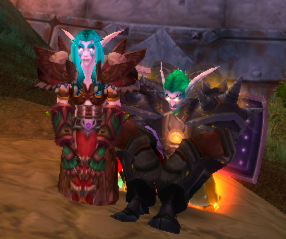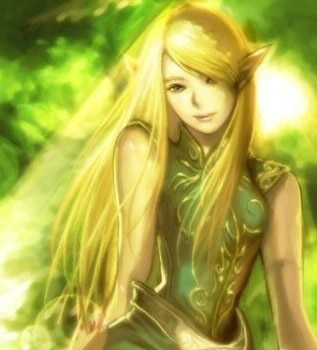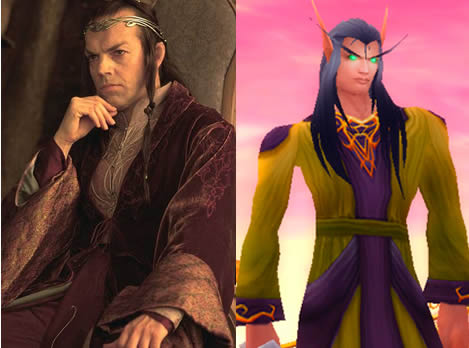Ah, the Burning Crusade, how I loved thee. On the eve of the expansion, I think it’s time to take a look back at some of the high points of BC. Mind you, I can only speak for myself, and my personal journey. I’m sure there are players out there–and probably even better players than me–who found their glory days in Classic. However, the expansion was where I, and Syd of course, made the difficult transition from total noob to raider. I’m proud of my progress, but I couldn’t have done it without the support structures that the game itself put in place.
Leveling
Perhaps the most dramatic difference between Classic and BC had to do with the leveling content. Once I stepped through the dark portal, I knew that I had entered an entirely new world (and it had nothing to do with the two moons and the streak of interstellar dust hanging overhead). Quests were conveniently grouped, and most could be done quickly. Now, in the interest of full disclosure, I ought to tell you that I bought the expansion two weeks late, and that when BC was actually released, Syd was only level 40. I probably hit Hellfire three weeks after the crowd, so it truly was an open world and I was able to blaze through.
However, I leveled Syd with the Vanilla WoW mindset. I did every quest in the zone that was appropriate for my level, assuming that in order to get enough XP to level up, I’d have to shift between, say, Hellfire and Zangarmarsh, like players had to do between Alterac, Stranglethorn Vale, and the Badlands. Imagine my surprise when Syd hit 70 after finishing less than half of Nagrand. On the whole, the leveling experience was quick and convenient.
Preparing for Karazhan
The old Karazhan attunement required an extended tour of level 70 dungeons. At minimum, players had to complete a full run of Shadowlabs (minus Murmur if you just couldn’t get him), a partial run of Steamvaults, a partial run of Arcatraz, and full runs of Old Hillsbrad Foothills and Black Morass. For the first few players in a guild to reach 70, runs of Sethekk Halls, Mechanar, and Botanica were needed for the keys to some of these lovely places.
The Karazhan attunement was the first thing I ever did in WoW in a businesslike, logical manner. I had raided a bit at 60, but let’s just say that I didn’t take ZG or MC as seriously as I could have. In order to get myself into Karazhan, I organized groups–who sometimes couldn’t clear the whole instance–and somehow pulled myself through it in greens and a Dreamstate spec. And then, all dimensions were open to me–I could get in the door to Karazhan.
Noob vs. Karazhan
I still remember my first Karazhan raid. It was led by a relatively experienced holy paladin, who shortly thereafter moved on to a raiding guild on another server. I managed to be Karazhan attuned right around the time that the leading players in my casual guild killed Prince for the first time. I started in my guild’s “B-team” Karazhan, and boy, did we deserve that distinction. I had 700 +healing when I walked into Attumen’s room for the first time, most of it “of Healing” greens (and cloth, at that). We did clear Attumen, but Moroes was a disaster. I realized that I needed to go back to the drawing board–way back. Even though I continued to run Kara when I could, I started running level 70 instances and the easiest heroics. I also leveled my tailoring and put myself in the PMC set.
14 Runs of Heroic Mech
Briolante decided that, in order to tank in Karazhan, he was going to need a Sun-Eater. We were clearing at least to chess around this time, and he had decided that the King’s Defender was in fact cursed and was never going to drop (turns out he was right, and it would be another 6 months before he’d see one of those–incidentally, a week before he’d get the Mallet of the Tides off Lurker). The Sun-Eater likewise suffered from the Curse of Tanking Drops, and it took us 14 runs over about 16 days to get the thing. In the process, I became a better healer. Heroic Mech was a little too hard for us in our blues–no one in our typical groups had gotten much out of Karazhan yet. I had to drop tree form to Healing Touch Brio through the Arcane Protectors’ Charged Fist effect, and I had to actively manage my mana to make it through the gauntlet. Pathaleon, who can still give a healer problems with his adds, taught me that NOT healing at the right moment can be just as important as healing. I waited until Pathaleon’s adds were targeting someone else, and then I followed with a Nature’s Swiftness-Healing Touch on Brio. I still usually died during the fight, and if we had a warlock, died more than once. However, we did get that Sun-Eater, Boots of the Pious for me, and a lot of primal nethers. I still have two nethers in my bank from those runs, because I never needed to roll on any after that.
Guild Master Syd
Right after Brio ended up with the Sun-Eater, our casual guild got dropped into my lap. Most of our best players had departed, and I was left with a motley assortment of some good and some mediocre players. I’m still not sure why I volunteered to lead them, but I remember agonizing over what to do with a casual guild who could reliably kill Prince Malchezzar but not go beyond. We ended up merging with our friends from another guild, forming Collateral Damage. The merger plans were successful beyond my wildest dreams. When we formed up CD, my goal was just to see the inside of Hyjal. Below, you’ll find Brio and me completing that goal. We’re chilling in Hyjal. . . but wearing our T6 while doing it.
Progression
When Collateral Damage started SSC, I was a total noob. So were most other people! The one thing that was unique about what we did was that we coached each other, with the most experienced leading the way, and the guild as a whole really taught casuals to raid. Most successful raiding guilds start out with a corps of players who already know how to raid; in contrast, we had to build from the ground up. During SSC, we were all reading up like mad on our class mechanics and on the fights. Looking back, I have to say that SSC was a really well-designed instance, much better than, say, TK, where we didn’t spend quite as much of our time. Each fight in SSC formed a piece of the raiding skills primer. Sure, they are all relatively easy, but the basic lessons carried over even into Sunwell. Lurker and, to a greater extent, Vashj, taught players to move out of the bad stuff. Hydross taught us the finer points of not pulling aggro at the wrong time. Morogrim introduced us to dealing with adds AND a hard-hitting boss at once, and with some healers incapacitated at that. Karathress really tested our ability to perform specific assignments, and Leotheras taught us to multitask. There’s a reason I still love SSC.
Once Vashj died, CD was able to progress smoothly through BT and Hyjal in a lot less weeks than it took us to conquer T5. Attunements got removed between our kills of Vashj and Kael, and the badge gear we were able to access gave us a gear buffer that let us clear the end bosses of SSC and TK less times than guilds that went through earlier would have had to. We were–and still are, really–great at progression but laughably bad at farming. Somehow the excitement just isn’t there, and our players tend to be really sloppy once we’ve killed something once. This is the one flaw of CD that I hope to correct for the expansion. I want fast, fun, efficient, happy clears of farm content.
Tier 6
And there we were, in Tier 6. And, I have to say, it didn’t disappoint. While most of the fights of Hyjal and BT were less difficult than Vashj and Kael, many of them are unique and interesting. Of course, I didn’t love the Hyjal trash, but we progressed so quickly in there that we only rarely had to re-clear it. If there had been trash before Archimonde, well, I would have written some nasty letters. Regarding BT, I like to think of it as Karazhan Part II with more inventive boss fights. To my mind, the best-designed fights of Karazhan are Shade of Aran and Netherspite. I love fights that get raiders thinking outside the box. In that vein, Teron Gorefiend, Reliquary of Souls, and Illidan himself are very enjoyable bosses to learn and master. I think my least favorite encounter in the dungeon is Bloodboil, as it’s so insistent on AoE healing, and at the time, I couldn’t do that. But I do enjoy hopping in the water to take my Bloodboil on schedule.
Quel’Danas and the Sunwell
I have to applaud Blizzard for the mechanisms they used to introduce the isle of Quel’Danas and the Sunwell. The progressive reveal created a very real sense of excitement and anticipation. I was eager to do my part to unlock the Badge Vendor, and I took Syd and two alts through the QD quests almost daily. I loved the sense of a server-wide effort. In addition, QD became the place to see and be seen, and I liked running into raiders from other guilds out in the world. As for the Sunwell, I have to admit that it was never part of my ambitions for CD. I knew we didn’t have time to get there ahead of the 3.0 patch. We did, however, kill Archimonde and Illidan in their original form. Going into Sunwell now just for fun, I realize that it’s a different place. We killed Kalecgos and Brutallus easily, and they’re not meant to be simple fights. However, I appreciate the beauty and grace of the instance–it’s nice to see a dungeon that isn’t gloomy, but rather permeated with light and beautiful colors. And hey, Felmyst is still hard–we haven’t killed her yet. I think we’ll continue to work on it just so we see the bosses and get that Kil-Jaeden achievement–even if we have to do it at 80.
Patch 3.0
Maybe I just didn’t care much, but when patch 2.0 hit, nothing changed for me. I continued to play my sometimes holy, sometimes ret paladin the same way I always did. However, 3.0 was something I anticipated, read about, and alternately wished for and dreaded. I have been obsessively following the continuing blue posts in the class and raid role forums, and I have to say, I’m a little disappointed. I like the level of communication players are getting, especially from Ghostcrawler, but I’m getting the feeling that the expansion is being rushed out before it’s actually ready. Sure, the content is all there, but class balance is a mess. And that, my friends, is a shame. I, for one, don’t think I should be worried about a major nerf at this point, as it looks like, with no more time to test or gather data, a 6-second cooldown will be applied to Circle of Healing and Wild Growth. Now, I do have to say, that of possible nerfs, the cooldown menaces Wild Growth the least, but it does leave me wondering what I’m supposed to be casting in a raid, now that Lifebloom is more or less off the table as well. But I digress. This little anecdote was meant to illustrate my sneaking suspicion that Wrath isn’t really ready for retail yet. This change, and others, make me think that the end-game has actually been designed to be too easy, and that they are scrambling to nerf healers or other strong classes to slow players down.
The Last Days of Waiting
We’re down to the wire now, so to speak. I actually spent some of my usual play time writing this article. Aside from a little EZ-mode raiding, it’s hard to play right now with any enthusiasm. Somehow, waiting for Thursday becomes a little more difficult when I interact with others who are doing the same thing. And what will I, and Syd, be like in the expansion? Will I build on my successes, or should I enshrine my T6 jersey as my greatest in-game accomplishment? The answer? I don’t really know yet.




